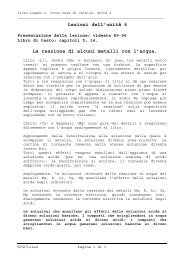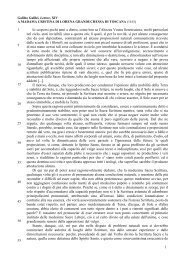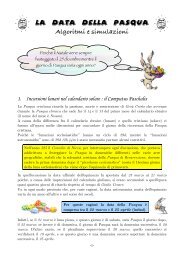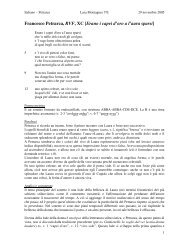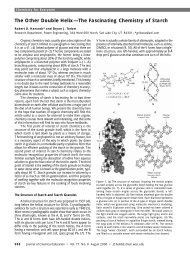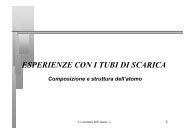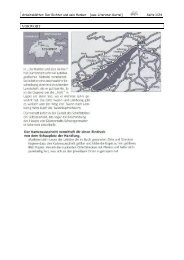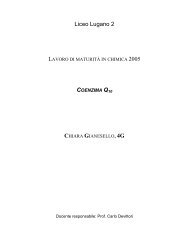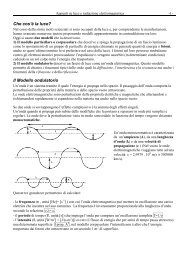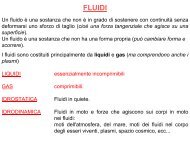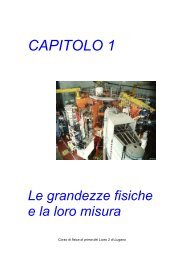Supercritical impregnation of polymers - ZyXEL NSA210
Supercritical impregnation of polymers - ZyXEL NSA210
Supercritical impregnation of polymers - ZyXEL NSA210
You also want an ePaper? Increase the reach of your titles
YUMPU automatically turns print PDFs into web optimized ePapers that Google loves.
I. Kikic, F. Vecchione / Current Opinion in Solid State and Materials Science 7 (2003) 399–405 401<br />
For 5-fluorouracil at 55 °C and 207 bar, the impregnated<br />
amount was very low (0.49).<br />
For these specific applications the drug loadings obtained<br />
are even higher than necessary since the therapeutical<br />
level for these products is much lower [12].<br />
Kazarian and Martirosyan [4] used ATR-IR spectroscopy<br />
to study the process <strong>of</strong> <strong>impregnation</strong> <strong>of</strong> ibupr<strong>of</strong>en<br />
into poly(vinyl pyrrolidone) (PVP) from SCCO 2<br />
solution.<br />
In situ spectroscopy allows the continuous monitoring<br />
<strong>of</strong> the amount <strong>of</strong> the impregnated drug, and the<br />
process can be instantly stopped by depressurising the<br />
high-pressure cell once the desired level is achieved.<br />
It has been shown that the supercritical fluid <strong>impregnation</strong><br />
process results in ibupr<strong>of</strong>en being molecularly<br />
dispersed in a polymer matrix where all drug<br />
molecules are H-bonded to the polymer and without the<br />
presence <strong>of</strong> ibupr<strong>of</strong>en crystals.<br />
ATR-IR spectroscopy has also revealed specific interactions<br />
between CO 2 molecules and carbonyl groups<br />
<strong>of</strong> PVP and it has been shown that a competitive interaction<br />
<strong>of</strong> impregnated ibupr<strong>of</strong>en molecules with the<br />
carbonyl groups <strong>of</strong> PVP prevents CO 2 molecules from<br />
interacting with the carbonyl groups <strong>of</strong> PVP. In addition,<br />
IR spectroscopic evidence has proved that similar<br />
interactions have an effect on water uptake into PVP.<br />
Thus, the PVP films impregnated with ibupr<strong>of</strong>en show<br />
much lower water uptake, presumably due to the competitive<br />
interaction <strong>of</strong> ibupr<strong>of</strong>en with basic carbonyl<br />
groups <strong>of</strong> PVP [4].<br />
3.2. Dye <strong>impregnation</strong><br />
In the dyeing processes <strong>of</strong> the textile industry, the use<br />
<strong>of</strong> supercritical carbon dioxide as an alternate solvent<br />
instead <strong>of</strong> water-based processes has been gaining much<br />
interest for environmental reasons. The conventional<br />
dyeing process <strong>of</strong> PET fibers discharges much wastewater<br />
that is contaminated by various kinds <strong>of</strong> dispersing<br />
agents, surfactants and unused dye. It is very difficult<br />
to design a conventional biological process that treats<br />
the wastewater discharged from a conventional dyeing<br />
PET process.<br />
The environmentally friendly supercritical fluid dyeing<br />
(SFD) process does not require any water, dispersing<br />
agents or surfactants and also does not involve any<br />
drying stage after dyeing. However, supercritical fluid<br />
dyeing has not been adopted in any <strong>of</strong> the world dyeing<br />
industries yet due to the high initial investment cost.<br />
Therefore, it may be better to apply the SFD to the<br />
hard-to-dye materials such as aramid, PE and PP fibers<br />
and films.<br />
Although extensive studies have been performed by<br />
several researchers, only a limited amount <strong>of</strong> basic dyesorption<br />
data is available. The amount <strong>of</strong> dye sorption<br />
in <strong>polymers</strong> in the presence <strong>of</strong> supercritical carbon dioxide<br />
is closely related to both the solubility <strong>of</strong> dye in<br />
the fluids and the distribution <strong>of</strong> dye between the fluid<br />
and the polymer phases. The mobility <strong>of</strong> dye molecules<br />
between polymer chains is generally enhanced due to the<br />
swelling <strong>of</strong> <strong>polymers</strong> in the supercritical fluids [13].<br />
Park and Bae [14] performed the measurement <strong>of</strong><br />
equilibrium dye uptake in PET fiber at various temperatures<br />
and pressures using a flow-method. The distribution<br />
coefficient increases with the pressure increase,<br />
because the sorption <strong>of</strong> dye in PET fiber increases more<br />
slowly with the pressure than the dye solubility in carbon<br />
dioxide does. This tendency is weakened with increase<br />
<strong>of</strong> temperature [14].<br />
Shim et al. [13] investigated sorption <strong>of</strong> some disperse<br />
dyes (C. I. Disperse Blue 60 (B60), C.I. Disperse Red 60<br />
(R60), C.I. Disperse Yellow 54 (Y54), and C.I. Disperse<br />
Orange 30 (O30)) in polyethylene terephthalate (PET)<br />
and polytrimethylene terephthalate (PTT) fibers as well<br />
as difficult-to-dye fibers such as aramid and polypropylene<br />
using supercritical carbon dioxide at pressures<br />
between 10 and )33 MPa and temperatures between 35<br />
and 150 °C. For dyeing in a co-solvent laden supercritical<br />
fluid, ethanol, acetone, or N-methyl pyrrolidone<br />
was also introduced in the dyeing vessel.<br />
PET and PTT fibers were easily dyed with Y54 and<br />
other dispersed dyes. The amount <strong>of</strong> sorption <strong>of</strong> Y54<br />
dye in the crystalline polyester textile fibers increased<br />
with increasing pressure up to 33 MPa at various temperatures.<br />
The amount <strong>of</strong> sorption for PTT was (about<br />
10%) larger than that for PET because PET has a high<br />
degree <strong>of</strong> crystallinity <strong>of</strong> 30% which is larger than that<br />
for PTT.<br />
Dye molecules are generally large and their diffusion<br />
rate is very small. They may penetrate only into the<br />
glassy part and not in the crystalline part <strong>of</strong> a polymeric<br />
matrix.<br />
Dye sorption increased with pressure at the same<br />
temperature and increased with temperature at the same<br />
pressure, but this increasing rate was reduced with increasing<br />
pressure [13].<br />
Van der Kraan et al. [15] studied dyeing <strong>of</strong> synthetic<br />
and natural textiles with a reactive dichlorotriazine dye<br />
in the presence <strong>of</strong> supercritical carbon dioxide.<br />
Experiments were carried out on polyester, silk, wool,<br />
cotton and aminated cotton. Pressure and temperature<br />
were varied from 225 to 278 bar and from 100 to 116 °C.<br />
In these experiments a small quantity <strong>of</strong> water was added<br />
as an enhancer <strong>of</strong> reactivity and/or accessibility <strong>of</strong><br />
the natural fibers. Polyester was dyed well, with fixation<br />
percentages in the order <strong>of</strong> 95% and the color yield increased<br />
with pressure, but not with temperature. Silk<br />
and wool were dyed with a color yield independent <strong>of</strong><br />
pressure and temperature. Fixation percentages on silk<br />
(76%) and wool (70%) were almost independent <strong>of</strong><br />
pressure and temperature. Comparison <strong>of</strong> the experimental<br />
results with literature data shows that silk can



